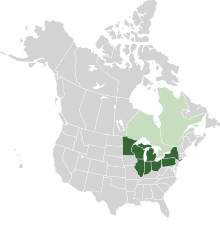
The Great Lakes Commission is a United States interstate agency established in 1955 through the Great Lakes Basin Compact, in order to "promote the orderly, integrated and comprehensive development, use and conservation of the water resources of the Great Lakes Basin,"[1] which includes the Saint Lawrence River. The Great Lakes Commission provides policy development, coordination, and advocacy on issues of regional concern, as well as communication and research services.
The eight member states are Illinois, Indiana, Michigan, Minnesota, New York, Ohio, Pennsylvania, and Wisconsin. The Canadian provinces of Ontario and Quebec are associate members.
There is a separate and distinct entity with a similar brief, the International Joint Commission, which exists between the federal levels of the United States and Canada.
See also
- Great Lakes and St. Lawrence Governors and Premiers
- Great Lakes
- Great Lakes Basin
- Great Lakes Compact
- Great Lakes–Saint Lawrence River Basin Sustainable Water Resources Agreement
- International Joint Commission
References
- ^ "Great Lakes Basin Compact" (PDF). Great Lakes Commission. Retrieved 2019-03-20.

